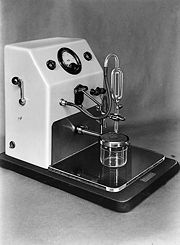
Holger F. Struer
Encyclopedia

Chemist
A chemist is a scientist trained in the study of chemistry. Chemists study the composition of matter and its properties such as density and acidity. Chemists carefully describe the properties they study in terms of quantities, with detail on the level of molecules and their component atoms...
and founder of "H. Struers Chemiske Laboratorium" (In Danish: "Struers Kemiske Laboratorium") in 1875 at Skindergade
Skindergade
Skindergade is a street in central Copenhagen, Denmark. Running roughly parallel to Strøget, to which it is connected through Jorcks Passage, it extends for approximately 400 metres from Gammeltorv to Købmagergade....
38, the centre of Copenhagen
Copenhagen
Copenhagen is the capital and largest city of Denmark, with an urban population of 1,199,224 and a metropolitan population of 1,930,260 . With the completion of the transnational Øresund Bridge in 2000, Copenhagen has become the centre of the increasingly integrating Øresund Region...
. Struers introduced in 1943 Micropol, a new principle for electrolytic polishing which made the preparation process within metallography
Metallography
Metallography is the study of the physical structure and components of metals, typically using microscopy.Ceramic and polymeric materials may also be prepared using metallographic techniques, hence the terms ceramography, plastography and, collectively, materialography.-Preparing metallographic...
more controlled in order to achieve better preparation results.
The development of metallography was a continuous struggle to find better and easier methods to prepare metal surfaces for microstructure observation. Struers based his new principle for electrolytic polishing on Count Alois von Beckh Widmanstätten
Count Alois von Beckh Widmanstätten
Count Alois von Beckh Widmanstätten was an Austrian printer and scientist. His name is sometimes given as Alois von Beckh-Widmannstätten or Aloys Beck, Edler von Widmannstätten.-Working life:...
and his early experiments from the beginning of the 19th century that revealed the structure of iron from a meteor which had come down earlier in the century. He noticed that the structure could better be seen on plane, fine polished surfaces. By pouring nitric acid over the surface and letting it react for some time, he actually made a deep etch which developed the macrostructure. Pieces etched this way were used for printing the structure directly on paper. These "nature prints" turned "metallography" into lithography. All these experiments did not lead to any evaluation of the microstructure, but were limited to the macrostructure.
However, in 1863 Henry Clifton Sorby
Henry Clifton Sorby
Henry Clifton Sorby , was an English microscopist and geologist.-Biography:Sorby was born at Woodbourne near Sheffield in Yorkshire and attended Sheffield Collegiate School. He early developed an interest in natural science, and one of his first papers related to the excavation of valleys in...
described in detail how he ground and polished samples in order to examine them under the microscope. He was able to magnify the structure up to 650x. From these observations he drew conclusions regarding the structure of pearlite and ferrite, and he was also able to watch the recrystallization of steel during cold working. For recording the microstructures he used three different methods available at the time: drawings, "nature printing" and microphotography. Considering that his research in the area of metallography only lasted two years, he discovered and established a wealth of information, and Sorby is considered to be the founder of metallography.
Holger F. Struer saw the need for a laboratory making chemical analysis in the strongly developing "modern society", and in 1895 Struer began importing chemicals and instruments for the Danish market. In 1919 Struer obtained the Danish representation of the Austrian company, Reichert, a specialist in metallographic microscopes. The combination of chemical knowledge and the sale of metallographic microscopes changed the focus of Struer's company to metallography and metallographic analysis. In 1943 H. Struers Chemiske Laboratorium launched Micropol, and a new principle for electrolytic polishing was established.
The introduction of Micropol was a technological progress since in this way the materialographic preparation process became more controlled in order to achieve an optimal preparation result in the shortest possible time. Today metallography is a part of materials science in its own right and extends to all fields of application, including ceramics, composites, electronic components and other solid materials. H. Struers Chemiske Laboratorium is still active within metallography but is today just called "Struers A/S".

